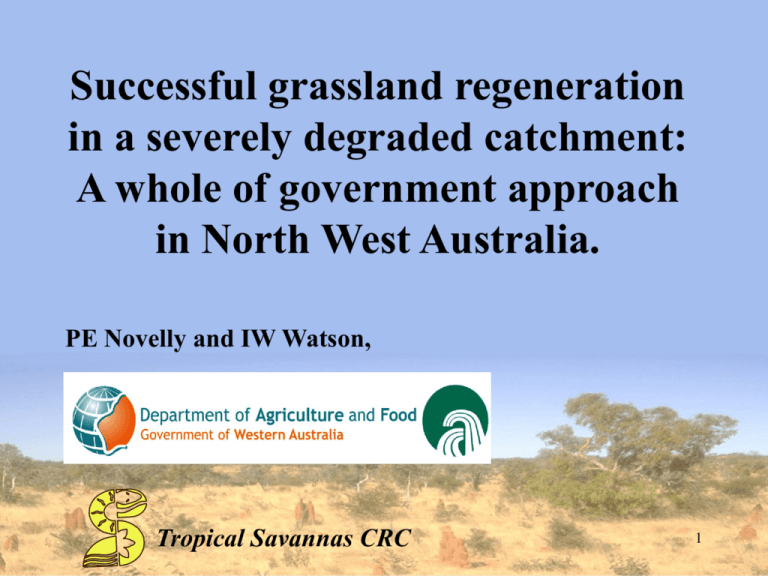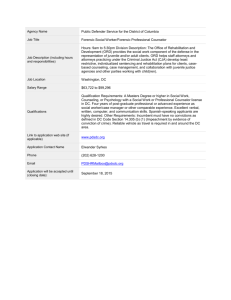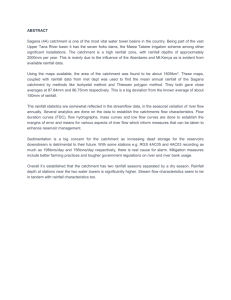Successful grassland regeneration in a severely degraded catchment
advertisement

Successful grassland regeneration in a severely degraded catchment: A whole of government approach in North West Australia. PE Novelly and IW Watson, Tropical Savannas CRC 1 INTRODUCTION The Ord River Regeneration Area in north-western Australia is an excellent example of the regeneration of degraded rangelands. However, such examples are rare. This presentation assesses this situation, not only from an agronomic viewpoint, but from a range of perspectives. 2 3 The Catchment covers an area of approximately 46 700 square km and is drained by the 650 km long Ord River. 4 CLIMATE • Monsoonal North-West Australia • Approximately 450 mm annual average rainfall, (with significant inter-annual variation) • Significant rainfall from late November to March 5 Average Annual Rainfall - Halls Creek 160 140 120 100 mm 80 Rainfall 60 40 20 0 Jul Aug Sep Oct Nov Dec Jan Feb Mar Apr May Jun 6 VEGETATION • Grassland / savanna woodland complex, tussock grassland (Astrebla, Chrysopogon, Aristida, Sehima) and hummock grasslands (Triodia). • Pasture type distribution determined by soil type and topography, providing a mosaic of different pastures and overgrazing on favoured types. 7 SITUATION • First European settlement in 1884, with reports of degradation within 25 years. • By the 1940s, an estimated 3,755 sq km were subject to varying degrees of erosion, with around 1,500 sq km subject to complete loss of grass cover and severe sheeting and gullying. • The average sediment load for the Ord River was 29 million tonnes per annum. 8 9 REHABILITATION PROGRAM A reseeding program using kapok bush (Aerva javanica) as a colonising species (to assist development of a favourable seedbed for native and sown species), buffel grass (Cenchrus ciliaris) and Birdwood grass (C. setiger) in contour ploughed bands began in 1960. 10 BUFFEL KAPOK 11 Cultivation - 1964 12 Contour furrows post-planting 13 Birdwood, buffel, kapok - 1965 14 RESULTS • Grassland rehabilitation was successful, with significant re-establishment of native grass species. • In 2006, the regenerated area was included in Western Australia’s conservation estate. 15 1975 2002 16 1963 2002 17 1963 2002 18 1963 2002 19 WHY WAS THIS PROGRAM SUCCESSFUL? Many programs of this type have been attempted, both in Australia and elsewhere. Most are not successful on this scale, and it is of value to identify WHY this particular program worked as well as it did. 20 1. THERE WAS A “CATALYST” FOR ACTION, BASED ON A CHANGE OF LAND USE • In the late 1950s, the decision was taken to develop a potential area of over 35 000 ha for irrigated agriculture downstream of the degraded area. 21 ORD RIVER IRRIGATION AREA - 2004 22 Lake Argyle and main Ord River Dam 23 Data suggested that without remediation, there would be a 30% reduction in reservoir capacity within 100 years. NEGRI RIVER 1963 24 “NEED” FOR A CATALYST? Financial returns per unit area for grazing land are low. Without the potential financial returns from the irrigation proposal, there would have been limited capacity (or even will) to initiate the rehabilitation program. 25 2. THE WESTERN AUSTRALIAN GOVERNMENT, NOT JUST AN INDIVIDUAL AGENCY OR DEPARTMENT, SUPPORTED THE PROGRAM • After initial (unsuccessful) attempts to work with the existing leaseholders, the area was resumed (2 leases in toto and portions of three others - 1 500 000 hectares), and gazetted a Water Catchment Reserve under Section 109 of the Land Act (1939-1965). • This was strengthened by The Ord River Dam Catchment Area (Straying Cattle) Act, gazetted in 1967 and amended in 1969, which vested ownership of all cattle found within the Reserve with the Government. • This provided the authority to develop a “workable’ program and deal with issues as they arose. 26 3. CONTROL OF ANIMALS WITHIN THE REHABILITATION AREA WAS RIGIDLY ENFORCED. • Between 1961 and 1990, 143000 cattle were recorded as being removed from the area; from 1979 to 1981, 15138 donkeys were shot from helicopters. This was by no means all of those removed. • From 1994 to 2000, 2503 donkeys and 1148 cattle were removed. • Animal “control” was not fully achieved until the early 1990s. Rehabilitation success reflected this. • Currently stock free. 27 4. RAINFALL • Rainfall, the major driver for success, was totally beyond management control. • Significant and extended periods of “poor” rainfall were recorded, with rehabilitation “stagnating” during such periods. 28 Ord River Regeneration Reserve Annual (July to June) rainfall anomaly (1959/60 - 2001/02) 600 Deviation (mm) from mean 500 400 300 200 100 0 -100 -200 -300 -400 59/60 64/65 69/70 74/75 79/80 84/85 89/90 94/95 99/0029 5. TIMEFRAME or INSTITUTIONAL PATIENCE • Reseeding continued until 1990; animal control is on-going. • A 1981 assessment showed rehabilitation was incomplete, and reviews in the mid-1980s and 1990 highlighted concerns that sediment loads were still unacceptably high, with some areas still fairly denuded. • There was a significant recovery in the 1990s, driven by good seasons and final control of feral cattle. 30 CONCLUSIONS • Assessment of rehabilitation programs often concentrates on more “technical” issues – the species used, the agronomy etc. • This assessment clearly illustrates that “success” in rehabilitation requires more than technical expertise. Strong commitment from Government, associated with a willingness to make “hard” decisions is important, as is an initial acceptance that timeframes will be long. 31 1963 2002 32




